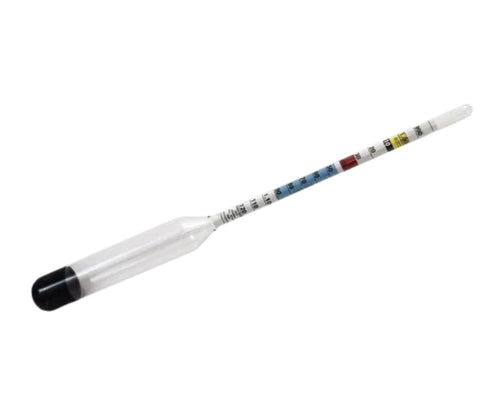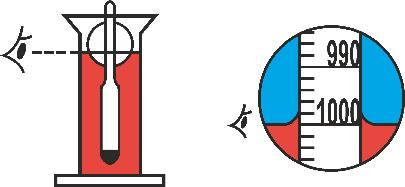Using a Triple Scale Home Wine and Beer Hydrometer - tips for use
If you have arrived here because you want tips for using a triple scale home wine and beer hydrometer, you have come to the right place.

There is an instruction leaflet inside the hydrometer tube, wrapped around the hydrometer. This article is designed to supplement that leaflet, as it contains more detail about using a hydrometer and takes into account the questions we've received from customers over the years about general hydrometer use. We have also written in the past about how to use a hydrometer to work out how much sugar to add.
Important point if you are a new hydrometer user: if you want to know the alcohol content of your cider, wine, beer or mead, you need to use your hydrometer at the start of the brewing process. We get emails from customers saying that they've made their wine and now want to know its alcohol content. Unfortunately at that stage it is too late to find out. You will need two readings from your hydrometer. One taken at the very start of the brewing process, and one at the end. The difference between the readings is what tells you the % alcohol content. So if you didn't take a reading at the start of the process, unfortunately it's too late to work out your alcohol content at the end. Our best advice at this point is to put it down to experience and remember to take a reading next time.
So now we've covered that, let's talk a bit more about your hydrometer.
Triple Scale Home Wine and Beer Hydrometer
Made by hydrometer production market-leader Stevenson-Reeves, this easy-to-read triple scale hydrometer is 23 cm long and has 3 scales for measurement.
It is made of glass and is therefore fragile. The slender stem is particularly easy to break. It goes without saying therefore that we recommend you handle your glass hydrometer with care. Do not put it in boiling liquid. If you do that, the glass will shatter.
The 3 scales for measurement are:
- Specific gravity - with a range of 0.98 to 1.12 at 20°C
- Sugar scale - with a range of 0 to 270 grams per litre
- Potential alcohol scale for wines only of 5 to 17%
The coloured bands on the hydrometer indicate where to start and finish wines and beers, plus there is an indication for sweet/medium/dry finished wines. The hydrometer comes packed in a strong clear plastic tube along with an instruction leaflet.
Trial Jar
The tube in which the hydrometer is packed doubles as a trial jar, which is what most of our customers use it for, as well as storing the glass hydrometer safely away after use.
Some customers have told us they prefer a glass trial jar. We no longer sell them, simply because they tend to be extremely fragile. They either don't survive being posted, or get broken very quickly in use. We have at least one customer who bought multiple glass trial jars from us and at some stage we worked out this wasn't a viable option for us as a predominantly online business.
Glass trial jars are, of course, widely available like this trial jar.
A Hydrometer doesn't work like a Thermometer
Whilst a glass hydrometer bears a resemblance to a thermometer, it contains no liquid and nothing moves. It is a strange concept in a way, and we understand when customers think the hydrometer is broken because nothing is moving when they put it in their homebrew. But a hydrometer is not designed to work in the same way as a thermometer does.
It is designed to sit in liquid and, where the scale meets the liquid, that is your reading.
If you are using a hydrometer to measure the alcohol content of your brew, you will follow the following process twice. Once at the beginning with your mix of fruit juice, flowers, whatever you are using, before it has fermented. Then once again at the end when everything has finished fermenting.
How to use your Triple Scale Home Wine and Beer Hydrometer
1. Make sure the hydrometer and trial jar are clean. We would normally sterilise them in a cleaner/steriliser such as VWP. Even if you do that, some brewers don't recommend putting the trial liquid back into the bucket or demijohn afterwards. It is up to you.

2. Place the trial jar on a level surface so that the hydrometer will float straight. Place a sample of the liquid to be tested into the tube. Use enough liquid so that the hydrometer will float, then lower the hydrometer carefully into the jar. The best way to get your sample is to use a pipette or 'wine thief' so that you don't disturb the sediment in the bottom of the fermenting vessel.
3. Spin the hydrometer to remove clinging bubbles. Make sure the hydrometer is floating straight and that the stem is not touching the sides. When the hydrometer is steady, read at the bottom surface of the liquid as shown in this diagram.

The reading shown in this example is 1.000, not 0.998.
4. Record the gravity reading.
5. Adjust the gravity reading for temperature. This is because hydrometers are calibrated to different temperatures. This one is calibrated for use at 20°C (68°F).
|
Add the corrections above to the specific gravity reading if the liquid you've tested is not at that temperature.
Calculating Alcohol Content
When you repeat the above process at the end of brewing, you will have two readings. One when you started, when you effectively measured how much sugar was in your liquid before the yeast started working. Then another at the end, when a percentage of the original sugar has been converted into alcohol.
You will use the scales in the table below to calculate your alcohol content. To do this, find the alcohol calculation values that correspond to your initial and final readings. Subtract the final reading from the first reading to get your % alcohol content.
Comparative Scales
|
Specific Gravity at 20°C (68°F) |
°Brix/Balling/Plato % sugar by weight |
Dissolved Sugar (grams per litre) |
Dissolved Sugar (oz per UK gallon) |
% Alcohol Calculation |
|
0.980 |
|
|
|
-2.6 |
|
0.985 |
|
|
|
-1.9 |
|
0.990 |
|
|
|
-1.3 |
|
0.995 |
|
|
|
-0.6 |
|
1.000 |
0.0 |
0 |
0 |
0.0 |
|
1.005 |
1.3 |
13 |
2 |
0.6 |
|
1.010 |
2.6 |
26 |
4 |
1.3 |
|
1.015 |
3.8 |
39 |
6 |
1.9 |
|
1.020 |
5.1 |
52 |
8 |
2.6 |
|
1.025 |
6.3 |
64 |
10 |
3.3 |
|
1.030 |
7.6 |
78 |
13 |
3.9 |
|
1.035 |
8.8 |
91 |
15 |
4.6 |
|
1.040 |
10.0 |
104 |
17 |
5.3 |
|
1.045 |
11.2 |
117 |
19 |
5.9 |
|
1.050 |
12.4 |
130 |
21 |
6.6 |
|
1.055 |
13.6 |
143 |
23 |
7.3 |
|
1.060 |
14.8 |
157 |
25 |
8.0 |
|
1.065 |
15.9 |
169 |
27 |
8.7 |
|
1.070 |
17.1 |
183 |
29 |
9.3 |
|
1.075 |
18.2 |
195 |
31 |
10.0 |
|
1.080 |
19.4 |
209 |
34 |
10.7 |
|
1.085 |
20.5 |
222 |
36 |
11.4 |
|
1.090 |
21.6 |
235 |
38 |
12.1 |
|
1.095 |
22.7 |
248 |
40 |
12.8 |
|
1.100 |
23.8 |
261 |
42 |
13.6 |
|
1.105 |
24.9 |
275 |
44 |
14.3 |
|
1.110 |
26.0 |
288 |
46 |
15.0 |
|
1.115 |
27.0 |
301 |
48 |
15.7 |
|
1.120 |
28.1 |
314 |
50 |
16.4 |
Trouble Shooting
Question: My hydrometer isn't doing anything. Is it broken?
Answer: Your hydrometer isn't designed to do anything, as such. It simply sits in the liquid you are measuring, and you take a reading where the liquid sits against the hydrometer scale. It is not like a thermometer, there is no mercury to move or any moving parts at all.
Question: My hydrometer is sinking to the bottom of the liquid. Is it broken?
Answer: Add more liquid to the trial jar. If there isn't enough of a sample in there, the hydrometer won't float.
Question: I forgot to take a reading when I started making the wine, I now want to know the alcohol content now the process is finished.
Answer: Unfortunately it's too late to calculate the alcohol content of this batch of wine. The calculation is a substraction of one reading from another so, if you are missing one of the readings, you can't work it out. We can only suggest you make another batch of the same wine and take a reading at the beginning next time. Assuming you are using the same kit and/or exactly the same ingredients, the chances are the alcohol content of both wine batches will be similar.
Final Thoughts
A hydrometer is a useful tool for measuring alcohol content. It can also be used to check the progress of your fermentation, as your final reading will fall as your sugar is turning to alcohol. If all fermenting activity seems to have finished, you can find out for sure whether it has. Take a hydrometer reading 3 days in a row. If the reading doesn't change, it is highly likely that fermentation has finished and you are ready to bottle.
OTHER ALMOST OFF GRID FAVOURITES:
Using a hydrometer to work out how much sugar to add
Making Wine from Garden Grapes
Is it ok to use Expired Yeast?
[This post contains links to our webshop and/or affiliate links to other shops. If you click on them, I may make a small commission at no extra cost to you. Find our disclosure policy here.]
